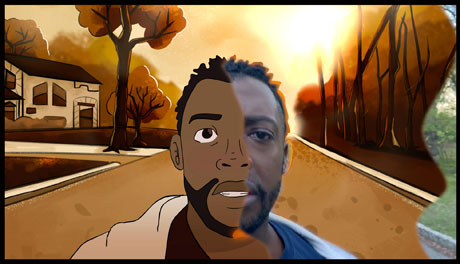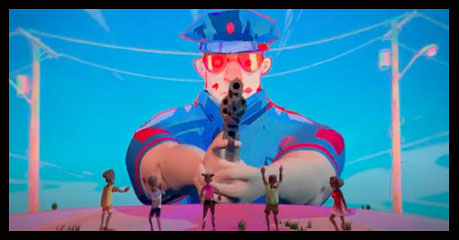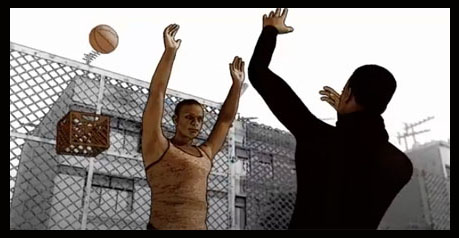
This Monday December 28th, Netflix is debuting one of the most important and impactful pieces of filmmaking this year. The animated short Cops and Robbers comes from directors Arnon Manor (filmmaker and Sony Pictures visual effects producer), Timothy Ware-Hill (an actor) and animators from around the globe. They’ve created a work of art for the here and now, and they accomplished it in a relatively short amount of time.
Arnon Manor: I originally had the idea of finishing it in two weeks.

Timothy Ware-Hill: The base layer of our video is from a video that I released in May – the same title Cops and Robbers. It was a video I released in response to the video released of the killing of Ahmaud Arbery. I took a poem I had previously written and I decided to jog in my neighborhood while reciting it. I released it onto Facebook and Instagram and… it went viral. Arnon saw the video on Instagram and DM’d me and said… “I saw your video. Really inspired by it. I have an idea. I’d love to do an animated version of it.” And I said, “That sounds interesting. Very cool.” He pitched the idea to me. And the idea was to divvy up the poem into different segments, gather-up animators and VFX artists from all over the world to take those segments and give their interpretation of the poem. And we stitched that together as a quilt, which gives you this animated version of Cops and Robbers, where you see various animation and VFX styles throughout the piece.
That train started moving in May. And… we did have an ambitious timeline of re-releasing it in two to three weeks just so it could get more views. We didn’t go into it intending to get a distributor or anything like that. So to get Netflix on board ended-up just being the icing on top of the cake.

Timothy Ware Hill
Jackson Murphy: And what you’ve created is quite powerful. You say you weren’t looking for a distributor. Did Netflix find you guys?
TWH: As we were working through things, Arnon and I shared it to individual contacts and people we have personal relationships with. One of them is a good friend and mentor of mine, Lawrence Bender, who’s one of the producers, and Janet Jeffries, who’s one of the EPs on it. I shared it with them… and they saw it and wanted to be involved from there. Lawrence hit the ground running. It was an incomplete version at the time, but he started to share it with different people. Eventually it got to Ellen Goldsmith-Vein of Gotham Group, and then it eventually got to Jada Pinkett Smith, who’s also an Executive Producer on this. These six degrees of separation navigated us towards Netflix.
They saw the work in progress as well and said, “Hey, we would love to be your distributor.” It kind of happened organically. We weren’t seeking it, but after one person started seeing it and [sharing] it… that’s kind of how it snowballed into this beautiful thing we have now. We’re very grateful.

JM: Having Jada Pinkett Smith on board – the star power and the impact – seems to be really good for you.
TWH: It has been. She’s definitely the right fit for the piece. She understands the story from her own personal life from being a Black woman here in American and having a Black husband and having Black children who deal with the possible potential of police encounters, which potentially leads to police violence. I’ve had my share throughout my life of being pulled over and harassed for no reason and interrogated by cops for no reason. It’s great to have Jada on board. She’s been a real advocate for the piece.
AM: And status has nothing to do with it. Jada and her family obviously have a certain status. The implications of being Black in America has no relevance to your social status.

Arnon Manor
AM: My background is in animation and visual effects. I reached out to people I knew in the animation and visual effects world. Some of them were companies that work on big Hollywood movies and some of them are smaller. We started to create a team of individuals. Part of the idea of getting so many people was to think about in a global aspect. But it was also a production aspect. We wanted to do it for no money. The piece was about three minutes at that point. How is it for me to go and ask people, “Hey, can I have three minutes of animation?” versus if we reduce it down into chunks – into sentences – five or ten seconds long, it’s easier to go to either an individual or a company and say, “Hey, can you do five or ten seconds of animation for this?” And of course, once they saw the original piece that Timothy did, everybody was in.
JM: That’s smart. And one of the artists is from near where I live: Amber L. Jones from Albany, NY. What did she contribute to this?
TWH: She did the Black power fist [segment]. She moved pretty quickly. Her segment has a lot of movement to it. It has a lot of kinetic energy. She, like many of the other Black artists… we found her on Instagram. It was very important that 50%+ of the animators and post production team were Black because it’s a Black American experience. And we have our allies all over the world. We have animators from Vancouver to Toronto, L.A. to New York, Alabama, Mississippi, Georgia, in South America, in Uruguay, Germany, France and London. It was important that our allies who help to tell the story… they were telling it from observation. But it was important we had artists on there that could tell the story from experience as well. It changes how the art is told because it’s coming from a more personal place.
We have so many talented artists – some big studios and then we have individual, independent artists who work from their homes on their iPads who are a part of this. We have high school students.

AM: A high school in Manitoba.
JM: That’s amazing. For each of these artists, it’s gonna be a big deal in their cities, towns and communities for them to be a part of this because it’s gonna get huge play.
TWH: Everybody donated their time for this because they believed in the cause – the message – the Black Lives Matter message. Everybody contributed to their time because of that. There have been no dollars exchanged. And even the proceeds from Netflix, 100% of those, Arnon and I are donating to Black charitable organizations. As you talk about Amber getting this exposure and all those other artists, when we say Black Lives Matter, it has to be an action, it can’t just be a hashtag. Even though these artists gave their time for free, the hope is that big studios and companies who are lacking inclusivity and diversity on their teams… there is no excuse to say, “Well we don’t know any Black animators.” Through Cops and Robbers, we’re giving you a handful of them and there are a lot more. If we can find them, you can put in the energy and work to find them as well.
AM: The high school students that helped us actually graduated, so now we have another batch. And we already had a conversation with them [recently]. So we’re continuing those conversations with the artists to help them with the process. It wasn’t just a one-off. It’s a very important part of what we’re trying to achieve. And the animation process wasn’t just about, “Here’s your segment. Let’s talk about an idea.” Before we started with any of the animators (we had a little more than 30 segments), there were discussions about the history of the violence even going back into slavery and talking about significant figures. It was not just about execution. It’s also about the raw emotion that comes with the education and understanding and why we’re here at this point in time. This didn’t just happen overnight. It’s hundreds of years worth of history.
JM: That’s very important. I’m glad you did that. Arnon, you’re the VP of Visual Effects at Sony Pictures. It’s been quite a year for the movie industry, so how was it balancing all of that with working on this?
AM: This is a personal project. Being part of the film industry, obviously it’s a very tumultuous time. Productions have stopped due to COVID. They’re picking up now but… Everything we did, we did remotely. COVID was a big part of the production aspect. We worked around the world… and everything was done remotely. Timothy and I have never met in person yet.
JM: Wow.
AM: Everything was done via Zoom. Weekend work. Evening work. Early morning. 10am in the east coast; 7am on the west coast where I’m at.
TWH: Or late at night.
AM: We’re dealing with our day to day lives, as were the people working on the project. Everybody had a day job.
JM: I can’t believe you two haven’t met in person yet. It’s gotta happen at some point soon! Maybe it’ll be if an awards show happens in person. How do you feel about Netflix showcasing this as one of the main animated shorts they’re positioning in the upcoming awards season?
TWH: Any consideration of that sort is a blessing, an honor to have. That’s not why we initially went into it. The beautiful thing about if nominations come out is that it gives more exposure to the film and to the message. That’s at the forefront and center of everything. How do we get this message out? How do we keep this ball in the air? So that people who did march in the streets during this summer who may feel exhausted now don’t forget that we still have to continue to fight even beyond this point.
To have Netflix is a complete honor because they have arms that reach worldwide. When they release something new, they release it all at once and it goes to multiple countries. Netflix is the leader in bringing diversity to TV/Film. When you go to their site, you see every face. You see LGBTQ+ community. You see women leads and directors. You see people of color and Black people telling their stories through their own voices. It’s the right fit to be with Netflix. Even when we have our production meetings with Netflix, we look at the staff on the calls with us… it’s every color. It’s not just a group of white men running it. It’s women, men, non-binary… it’s everything. That’s the world that we want to live in, and Netflix is a microcosm of that possibility. So it’s really wonderful to be with them.
- INTERVIEW: “Inside Out 2” Director And Producer On Pixar Sequel - April 16, 2024
- INTERVIEW: “Puffin Rock And The New Friends” And 25 Years Of Cartoon Saloon - April 10, 2024
- INTERVIEW: “Chicken For Linda!” Directors On Annecy Winning Feature - April 9, 2024


 December 23rd, 2020
December 23rd, 2020  Jackson Murphy
Jackson Murphy  Posted in
Posted in  Tags:
Tags: 






